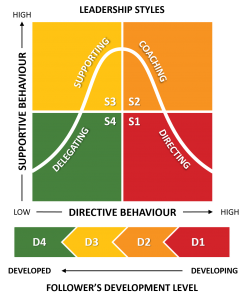Reflection 2 – Theory in Action: Situation Leadership in the Workplace
Reflecting on week two of my internship, I am drawn to compare my observations to Hershey and Blanchard’s Situational Theory of Leadership. The Situational Leadership Theory Model suggests that the most effective leadership style depends upon the circumstances (situations) leaders find themselves in. Equally as important is the willingness and ability of followership to perform tasks. Taken together, Hershey and Blanchard determined that leaders can adapt to different leadership styles depending on the conditions of followership. Notably, the different leadership styles are “Delegating”, where followers are willing and unable, “Supporting”, where followers are unwilling and able, “Coaching”, where followers are willing and unable, and “Directing” where followers are unwilling and unable.

At Pennsylvania Health Care Association, I observe shifts in leadership style among most of the staff in the office almost every day. Specifically for my internship, I have a supervisor and a designated mentor, each assigning and guiding me through projects. My supervisor oversees the daily operations of work in the office. As PHCA advocates on behalf of long-term care facilities, he assigned me projects researching future proposals for more efficient certification of certain staffing positions in these facilities. In this regard, my supervisor’s leadership style is reflective of Hershey and Blanchard’s “Coaching” style. As the follower, I am willing to complete the task, yet my lack of knowledge in the industry makes me unable to complete the research without “coaching”, defining the leadership style given the situation.
In contrast, I had the opportunity to sit in on the Harrisburg Regional Chamber and CREDC Government Relations Committee meeting, which hosted U.S. Senator Casey, with my supervisor. In this setting, my supervisor’s leadership style shifted from “Coaching” to “Supporting”, as he was a representative of the association, and by extension the long-term care industry. Others in the meeting were directors of their industry/association and representative members of the federal government; thus, my supervisor worked to stress the importance of workforce development and support within the industry. This is defined by the other attendee’s ability, yet unwillingness, to take action because of their own advocacy efforts. These two circumstances within the same week uphold Hershey and Blanchard’s Situational Leadership Theory through the shifts in leadership style given the changes in followership and audience.
